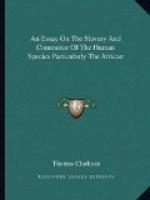The second epoch is that, when mankind were dispersed on the building of Babel. It has been thought, that both national features and colour might probably have been given them at this time, because these would have assisted the confusion of language, by causing them to disperse into tribes, and would have united more firmly the individuals of each, after the dispersion had taken place. But this is improbable: first, because there is great reason to presume that Moses, who has mentioned the confusion of language, would have mentioned these circumstances also, if they had actually contributed to bring about so singular an event: secondly, because the confusion of language was sufficient of itself to have accomplished this; and we cannot suppose that the Deity could have done any thing in vain: and thirdly, because, if mankind had been dispersed, each tribe in its peculiar hue, it is impossible to conceive, that they could have wandered and settled in such a manner, as to exhibit that regular gradation of colour from the equator to the poles, so conspicuous at the present day.
These are the only periods, which there has been even the shadow of a probability for assigning; and we may therefore conclude that the preceding observations, together with such circumstances as will appear in the present chapter, will amount to a demonstration, that the difference of colour was never caused by any interposition of the Deity, and that it must have proceeded therefore from that incidental co-operation of causes, which has been before related.
What these causes are, it is out of the power of human wisdom positively to assert: there are facts, however, which, if properly weighed and put together, will throw considerable light upon the subject. These we shall submit to the perusal of the reader, and shall deduce from them such inferences only, as almost every person must make in his own mind, on their recital.
The first point, that occurs to be ascertained, is, “What part of the skin is the seat of colour?” The old anatomists usually divided the skin into two parts, or lamina; the exteriour and thinnest, called by the Greeks Epidermis, by the Romans Cuticula, and hence by us Cuticle; and the interiour, called by the former Derma, and by the latter Cutis, or true skin. Hence they must necessarily have supposed, that, as the true skin was in every respect the same in all human subjects, however various their external hue, so the seat of colour must have existed in the Cuticle, or upper surface.
Malphigi, an eminent Italian physician, of the last century, was the first person who discovered that the skin was divided into three lamina, or parts; the Cuticle, the true skin, and a certain coagulated substance situated between both, which he distinguished by the title of Mucosum Corpus; a title retained by anatomists to the present day: which coagulated substance adhered so firmly to the Cuticle, as, in all former anatomical preparations, to have come off with it, and, from this circumstance to have led the ancient anatomists to believe, that there were but two lamina, or divisible portions in the human skin.




